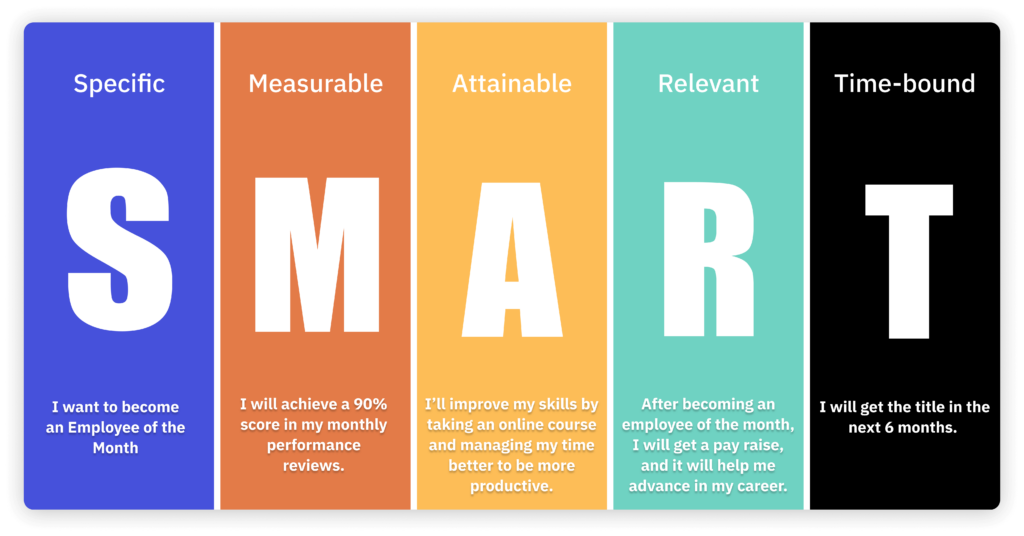Content
Content
How to Set SMART Goals (+ Examples and Template)
All of us are ambitious about what we want, but only a few can see their dreams turning into their living reality.
Just imagine you and your friend both are hunting for your dream job and one day, you get a call from him, “Hey! I got it!”
Obviously, you’ll be happy for him, but you’ll also feel a little disappointed in yourself. Well, feeling bad about yourself won’t get you your dream job, but setting a SMART goal can.
But what exactly are SMART goals? Let’s debunk this secret to help you become one of the exclusive ones.
Stay with us till the end because we are not just going to talk about SMART goals through real-life examples, but we will also provide a practical guide on how to set and achieve them with a free template.
What are SMART Goals?
SMART is an abbreviation for Specific, Measurable, Attainable, Relevant, and Timebound.
These parameters guide you in developing achievable personal or professional objectives.
It helps individuals and organizations to set clear, concise, and attainable goals in a specific timeframe.
For example:
You want to become an employee of the month. Only manifesting it won’t help. You’ll need to turn your vague goal into a SMART goal.
Here’s how you can go about it and turn the impossible into possible.

The above example represents how you can make your goals achievable just by elaborating and clarifying your steps.
Before we move to the actionable SMART goal techniques, template, examples, and benefits, let’s break down SMART goals in more detail.
I. Specific (S) Goals
“S” stands for Specific, the foundation of SMART goals. It represents a clear, concise, and well-defined objective. It answers the 5 Ws: who, what, where, when, and why.
“I want to start a business.” This is a preliminary goal.
A specific goal is: “I want to start a sustainable clothing business in the next six months in New York by renting a storefront in a trendy neighborhood and investing in social media marketing to create brand awareness and drive traffic to my store.”
Writing your specific goal would give you clarity. When you are clear about your goal, you can easily identify the necessary actions and focus your time and energy on achieving it.
II. Measurable (M) Goals
“M” in SMART goals represents Measurable. Your goals should be specific and quantifiable to measure your progress and easily determine your success.
“I want to learn graphic designing.” This is an immeasurable goal.
“ I want to learn graphic design by completing a beginner-level course and illustrating at least five designs by the end” is a measurable goal.
Determine your progress by specifying quantifiable metrics and regular tracking. This will further help you identify roadblocks and eliminate distractions.
You stay motivated as the metrics show you your ongoing progress, which fuels your ambitions and frees you from procrastinating.
III. Attainable (A) Goals
“A” in SMART goals is for attainable goals. While aiming for the moon is great, you must also be realistic about what you want. Attainable goals branch out into two significant aspects:
- Being realistic about your goal
- Identifying constraints that may stop you from progressing.
“I want to complete a 500-page book in 5 days.” Reading 100 pages a day is unattainable.
Attainable goal: “ I will complete a 500-page book by reading 10 pages daily.”
This goal is specific, measurable, and attainable.
Moreover, identify the roadblocks and find their solutions to ensure your goal becomes attainable.
Per se, you don’t have time to read 100 pages a day, but 10 pages are readable in a day. By removing the time constraint, you made it easily attainable.
IV. Relevant (R) Goals
“R” is for Relevant in SMART goals. It suggests that your goals must align with your vision and should be relevant to your life or career in some way.
To become a marketer, becoming a sales agent is irrelevant to your vision.
Taking a marketing certification course is a better goal. It aligns with your end goal, which will keep you motivated.
Other than aligning with your vision, prioritize your goals according to your current situation.
So if you want to become a marketer and don’t know anything about it, you can’t take up a job. You’ll have to take a course first.
Although you’ll need to do both: Complete the course and get experience to become a professional marketer, your current situation needs you to focus on learning rather than experience. So focus on taking a course and achieving this target before setting your next goal to achieve the end goal.
V. Time-Bound (T) Goals
“T” is a time-bounding parameter of SMART goals. In other words, it sets a deadline to complete a specific goal. Setting a deadline is important to create an urgency to achieve that target in a given timeline.
“I want to take a bar examination to open my law firm.” This is not a time-bound goal.
A time-bound goal is: “ I want to take the bar examination next year to open my law firm in the next 5 years.”
Without a specific timeframe, you’ll lose track of your progress and procrastinate. This can deviate your focus from your goal. To ensure you don’t procrastinate, divide your goal into achievable chunks.
For example, your end goal is to open a law firm in the next 5 years. To achieve this, you can break your journey into steps. First, set a time-bound goal to complete your bar. The next goal could be to get your license, get clients, etc. By achieving these smaller goals, you’ll open your law firm in the next 5 years.
How Can You Set SMART Goals?
When setting SMART goals, one can easily deviate from the purpose and cause minor errors that can accumulate to become failures. So, follow the practical tips below on how to set SMART goals for your personal or professional achievements.
1. How to Specify Your Goal?
The first step to identifying your goal is to be specific. Think about “S” as the mission statement for your SMART goal. It doesn’t have to be detailed but answer the following questions.
- Who is involved in achieving the goal? Answering this is important if you’re working on a group project; otherwise, it’s usually you alone.
- What do you want to accomplish? Write a paragraph, pointers, or any way you like. Make it detailed.
- When do you want to achieve this goal? The details are set in the “Time-bound” section, but you must have a timeframe.
- Where do you want to accomplish the goal? It is only necessary if your goal requires a particular specific location. Otherwise, you can skip.
- Which obstacles would you come across? Identify your hurdles and refine the specifics of the goal.
- Why do you want to achieve this goal? We’ll discuss this more in the “Relevant” section, but your goal must match your vision.
2. How to Make Your Goal Measurable?
To make your goal measurable, identify quantifiable metrics. It’ll make it easier for you to stay consistent as your goal becomes more tangible by providing a way to measure your progress.
If your goal will take a few months to complete, break the project into chunks, set milestones, and answer the following questions:
- How will I measure my progress?
- How will I know that my goal is accomplished?
Accomplishing small milestones will lead you to achieve your big project.
When writing your SMART goal, mention a source of information that measures or determines where you are in your journey to accomplish your goal.
To sum it up, M indicates what success will look like for your particular goal.
However, sometimes it is hard to measure your journey, and if you don’t have a plan to measure it, you must know why the goal is important to you and what your success will look like while you figure out a way to measure it.
3. How to Write Attainable Goals?
Once you identify how to measure your success, you must ensure your goal is achievable.
To ensure you complete this step, you must identify realistic ways of completing your goal if you want to open a business but don’t know it. So you can’t directly achieve your goal.
You must upgrade your business skills in a particular industry. The same goes for all types of goals.
Make it easier by answering the following questions:
- How can the goal be accomplished?
- What are the logical and realistic steps I should take to achieve my goal?
Making your goal measurable breaks your end goal into small chunks. And “A” is all about making those chunks achievable. The idea here is to figure out how to achieve your goals while knowing your limitations.
4. How to Make Your Goal Relevant?
As mentioned in the “S” section, your goal must resonate with your vision. When you are
writing your goal, ask yourself a few questions like:
- Why is this goal important to me?
- What difference will it make in my life?
- How is this goal helping me to achieve my end goal?
- Is this the right time to work on this goal?
Once you answer these, you’ll have a clear objective to move ahead. Whenever you’re demotivated, the answer to these questions will keep you going.
Remember to answer these questions as truthfully as possible.
5. How to Make Your Goal Time-Bound?
After creating a specific, measurable, achievable, and relevant goal, give yourself a time frame to achieve it.
Ask specific questions, for example:
- How much time will I take to complete this goal?
- When will I start working on this goal?
- What date is my goal due?
The following answers will help you create urgency for the tasks so you can achieve the goal under the set deadline.
Write your SMART goal in a few sentences with a call to action and fine-tune the strategy to ensure it remains attainable.
Use the below printable template as your guiding compass to write your first SMART goal.
Template for Creating a SMART Goal
Writing SMART goals helps identify realistic ways to accomplish your goal within a deadline. Be concise when planning your SMART goal, but include all the relevant information. This template is designed to help you write your goal successfully.

5 Examples Of Smart Goals
If you want to understand SMART goals more deeply, here are five real-life examples to help you clear all your confusion and get you started immediately.
Example 1: Applying SMART Goals in Personal Life
Your goal: “I want to lose weight.”
This is an unclear goal. It has nothing SMART. Let’s turn this vague goal into an achievable SMART goal.
- Specify your Target: I will lose X pounds or kgs in the next 3 months
- How will you measure? I will weigh myself every week and track my progress
- How will you Achieve? I will work out 30 minutes in the gym daily and follow a weight loss diet after consulting with my medical practitioner.
- How is it relevant? By losing weight, I’ll regain my confidence and improve my overall health and fitness.
- What is the time limit? I’ll accomplish my goal by the end of the third month.
So your SMART Goal will look somewhat like this:
“I want to lose 10 pounds to regain my confidence and improve my overall health by exercising 30 minutes daily and following a diet in the next 3 months. I’ll weigh myself every week to track my progress.”
See the difference? The latter will motivate you to keep going while giving you positive results. On the contrary, you’ll procrastinate if you stick to your unclear goal.
Example 2: SMART Goals in Professional Development
Your Goal: “ I want to do digital marketing.”
Identifying your goal isn’t enough. You need to have a clear plan to achieve them, and for that, you’ll need a SMART goal.
- Specify your target: I want to enhance my professional skills in digital marketing.
- How will you measure it? I will dedicate 1 hour every day to complete the online course and allocate 2 hours per week to work on the digital marketing plan.
- How will you achieve it? I will complete an online course and create a digital marketing plan for a real-world business.
- How is it relevant? Enhancing my skills in digital marketing will help me advance in my career as a marketing professional and increase my chances of getting promotions.
- When will you achieve the goal? I will complete the online course and create the digital marketing plan within the next 3 months.
Your SMART goal:
“I want to enhance my digital marketing skills in the next 3 months by taking a course and creating a real-world digital marketing plan. I’ll dedicate 1 hour daily to complete the course and allocate 2 hours to create a plan. Achieving this goal will help me advance in my career and increase my chances of promotion.”
Example 3: SMART Goals for Team Success
Your Goal: “Our team wants to increase sales.”
This vague goal doesn’t give much idea of how and what to do to achieve it. Let’s have a look at its SMART version.
- Specify your target: Our team wants to increase sales by 10% next quarter.
- How will you measure it? We will compare and track new sales statistics weekly.
- How will you achieve it? We will increase our monthly sales target by 2.5%, which is achievable and realistic.
- How is it relevant? Increasing sales would accomplish the team’s long-term objective and help the business grow.
- When will you achieve the goal? We will increase 10% sales by next quarters starting from today.
Your SMART goal:
“Our team will increase sales by 10% in the next quarter by increasing 2.5% sales monthly. We will track our progress by analyzing and evaluating weekly sales stats. This will help us reach our long-term objective and increase business.”
Example 4: SMART Goals in Education
Your goal: “I want to improve my grades.”
We all have been there where we used to aim to improve our grades at 2:00 a.m., and we also had an action plan. But since it wasn’t a SMART goal, the plan and target used to vanish as we woke up the next morning.
Let’s turn this universal goal of every student into a SMART goal.
- Specify your target: I want to improve my Math grade by the end of this semester.
- How will you measure it? I aim to increase my math test scores from 50% to 85%.
- How will you achieve it? I will start attending Math tuitions and solve at least 2 problems every day.
- How is it relevant? Improving my Math grade will improve my overall grade. Plus, it’ll help me get into a college of my choice.
- When will you achieve the goal? I will complete this target by the end of this
semester.
Your SMART goal:
“I will improve my Math grade by the end of next semester. I’ll increase my Math test score to 85% by joining tuition and solving problems every day. This will help me improve my overall grade and get into my dream college.”
Example 5: Setting SMART Goals in Business
Your goal: “I want to increase customer satisfaction ratings.”
Want to achieve it? Let’s turn this into an achievable SMART goal.
- Specify your target: I want to increase customer satisfaction ratings by 20% in the next two quarters.
- How will you measure it? By evaluating and analyzing customer satisfaction ratings on my customer service surveys for the next two quarters.
- How will you achieve it? I’ll improve customer service response times, train my customer care representatives better, and implement a feedback loop to gather and act on customer feedback.
- How is it relevant? Improving customer satisfaction will improve my brand image, increase revenue, retain existing customers, and attract new ones.
- When will you achieve the goal? I plan to achieve this within the next two quarters.
Your SMART goal:
“I will increase customer satisfaction ratings by 20% within the next two quarters by improving my customer service response times, training my team better, and implementing a feedback loop. By constantly evaluating and analyzing customer service ratings on my customer service surveys, I will improve my brand image, increase ROI, retain existing clients, and attract new ones.”
5 Major Benefits of SMART Goals
SMART goals help individuals and organizations focus on their objectives by eliminating distractions and organizing steps to reach the end goal. Here are the top 5 benefits of writing SMART goals.
i. Clarity and Focus
Decluttering clears the fog and helps you prioritize tasks. This helps you be specific about what you want to do and avoid distractions that can hamper your progress. SMART goals also break down huge tasks into chunks, making them achievable with visible results.
ii. Enhanced Motivation
As you start ticking the checklist, your motivation level rises. This will enhance your productivity, and you’ll get better ways to reach your end goal. When you see your progress graph rising, it will automatically push you to accomplish what you decided for yourself.
iii. Identify and Remove Obstacles
When you know your roadblocks, you can work on the solution for them. This will not let you procrastinate. When the path is clear, you don’t have any reason to procrastinate. You start achieving milestone after milestone, and you reach your goal in no time.
iv. Reduce Workload
“Too much work and too little time” is our excuse when we aren’t able to accomplish anything. But with SMART goals, you have fewer things to do and more time. So not only are you able to meet deadlines faster, but you also get productive outcomes.
v. Stay Accountable
When you are accountable for your success, you take full responsibility, pushing you to ensure you do what you’ve prioritized. It keeps you pushing until you achieve the goal. Moreover, this also helps you build better self-discipline.
How Can TimeBee Help Your Organization in Achieving SMART Goals?
TimeBee is a productivity and time-tracking tool that can be a valuable asset in achieving SMART goals for an organization:
a. Specific
TimeBee helps set specific goals by providing detailed insights into time spent. It allows you to break down tasks, allocate time to each, and track progress on specific activities.
b. Measurable
The platform offers quantifiable data on time spent on tasks and projects. With TimeBee, you can measure productivity, track hours worked on particular goals, and analyze the efficiency of workflows.
c. Attainable
By monitoring time spent on tasks, TimeBee helps assess whether the goals set are realistically achievable within the given time frame. It assists in identifying bottlenecks or areas where adjustments are needed for better goal attainment.
d. Relevant
TimeBee’s reports and analytics provide relevance by showcasing where time is allocated. It helps align individual or team efforts with organizational objectives, ensuring that the time spent contributes to the right areas.
e. Time-bound
The tool assists in setting time-bound goals by allowing you to schedule tasks, set deadlines, and track progress against these timelines. It helps in ensuring that goals are achieved within the specified time frame.
Conclusion
Gliding a mountain may seem impossible, but if you aim for it, you can achieve it. SMART goals help you navigate your route from doing nothing to accomplishing your lifelong goals. Download and print our template, and start drafting your SMART goal.
Don’t forget to implement your plans, because if you do nothing, you get nothing.
While you are busy acting on your goals, you’ll also need something to keep you accountable all the time. There are many options out there. For example, you can ask a friend or a family member to help you stay on track or use technology to improve outcomes.
In the end, whatever way you want, start writing SMART goals if you really want to achieve your goals.
Similar Reading



